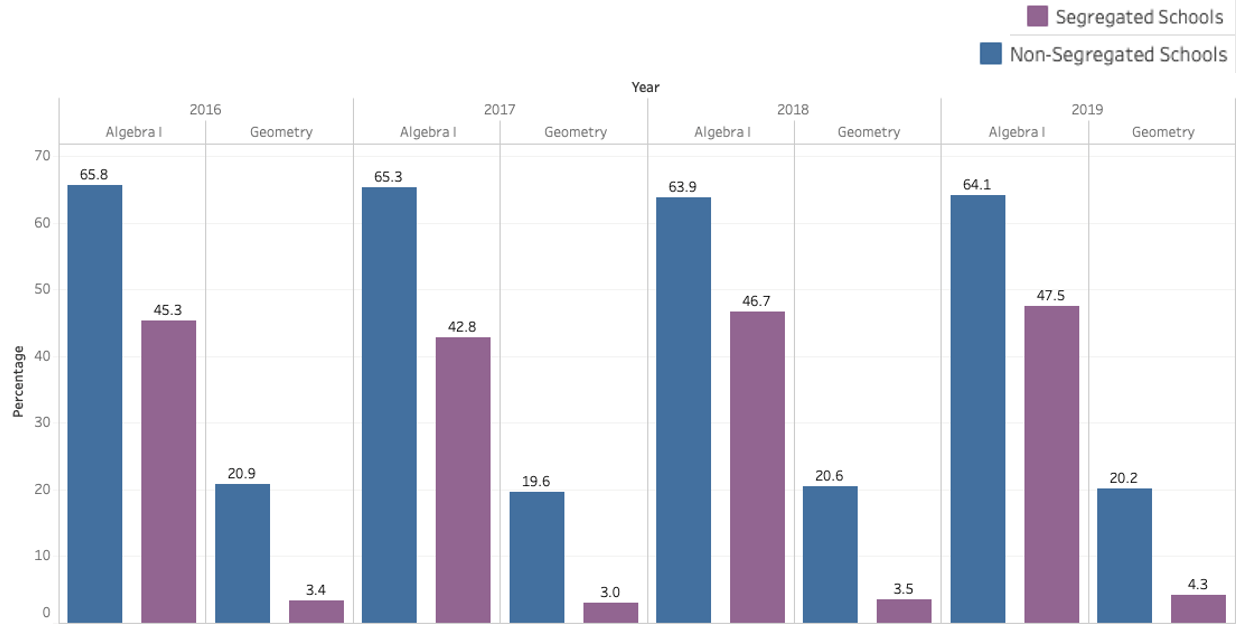Mathematics has long been considered essential to success in secondary and post-secondary education and in a labor market increasingly reliant on 21st century skills (Aughinbaugh, 2012; Kim et al., 2015). Furthermore, an understanding of complex math and problem-solving skills such as algebra is critical to citizenship in a democratic society (Moses & Cobb, 2002; Allen, 2011). Enrolling in Algebra 1 early is considered to be high-leverage because students who do not have access to it until secondary school are unlikely to have the opportunity to take advanced math courses such as Calculus and Advanced Placement (AP) math before they graduate. Taking an advanced course can contribute to improved math achievement (Long et al., 2012; Stein et al., 2011), college enrollment (Byun et al., 2015) and access to STEM fields (Warne et al., 2019). Low-income students and students of color who attend segregated schools are far less likely to have access to advanced math courses like Calculus in secondary school and even when they do, they often do not gain access to Algebra 1 until secondary school (Peters & Carter, 2021). According to data from the US Department of Education, Calculus is not offered in most schools that serve large numbers of Black and Latinx students (CRDC, 2016). Understanding issues surrounding racial and ethnic equity in education is pivotal to the work of the Joseph C. Cornwall Center for Metropolitan Studies.
Examining course offerings and enrollment is one of many lines of inquiry to monitor equity in mathematics participation in New Jersey. A preliminary look at the New Jersey Department of Education (NJDOE) School Performance data shows disparities in math course offerings between schools with 50 percent or more of students who are economically disadvantaged and have 90 percent or more non-White students (segregated schools), compared to schools that are economically and racially mixed (non-segregated schools). In our sample, 120 schools are segregated, and 420 schools are non-segregated.
Students in non-segregated New Jersey middle schools have far greater early advanced math course-taking opportunities. Almost two-thirds of non-segregated middle schools offered Algebra I compared to less than half of segregated schools in 2019. Thus, seven in ten students in segregated schools took Algebra I freshman year of high school while a quarter of those in non-segregated schools were already taking Geometry. This pattern continues throughout high school such that while the majority of tenth graders in both segregated and non-segregated schools are taking Geometry, almost a third in non-segregated schools are already ahead in taking Algebra II. Further, students in segregated schools concentrate on Algebra II course-taking in 11th grade but a quarter of students in non-segregated schools have moved on to take Pre-calculus and other math courses. Finally, only two in ten students in segregated schools end up taking more advanced math courses like Calculus and Statistics compared to four in ten of those in non-segregated schools in New Jersey.
Overall, these findings suggest that students in segregated schools in New Jersey do not have the same level of access to advanced mathematics coursework as those in non-segregated schools. Thus, part of the dialogue we hope to see in the state of New Jersey is that of increasing access and enrollment in advanced math courses as well as better preparing and supporting students to be successful in those courses once enrolled.
The gap in Algebra 1 course offering between segregated and non-segregated schools is as wide as 23 percentage points.

Note: Calculations are the authors’ and are based on data from New Jersey Department of Education School Performance Reports annual datasets.
References:
Allen, K. C. (2011). Mathematics as Thinking. A Response to “Democracy and School Math”. Democracy & Education. 19(2).
Aughinbaugh, A. (2012). The effects of high school math curriculum on college attendance: Evidence from the NLSY97. Economics of Education Review. 31(6), 861-870.
Byun, S., Irvin, M. J. & Bell, B. A. (2015). Advanced Math Course Taking: Effects on Math Achievement and College Enrollment. The Journal of Experimental Education. 83(4), 439-468.
Civil Rights Data Collection (CRDC). (2018). 2015–16 Civil Rights Data Collection Stem Course Taking 2015-16. https://www2.ed.gov/about/offices/list/ocr/docs/stem-course-taking.pdf
Kim, J., Kim, J., DesJardins, S. L. & McCall, B. P. (2015). Completing Algebra II in High School: Does it increase College Access and Success? The Journal of Higher Education. 86(4).
Long, M. C., Conger, D., & Iatarola. (2012). Effects of high school course-taking on secondary and postsecondary success. American Educational Research Journal, 49, 285–322. doi:10.3102/0002831211431952
Moses, R. P. & Cobb, C. E. (2002). Radical Equations: Civil Rights from Mississippi to the Algebra Project. Beacon Press.
Peters, S. J., and Carter III., J. S. (2021). Predictors of Access to Advanced Learning: What Makes for a Successful School?. (EdWorkingPaper: 21-403). Retrieved from Annenberg Institute at Brown University: https://doi.org/10.26300/wqsg-cq08
Stein, M. K., Kaufman, J. H., Sherman, M., & Hillen, A. F. (2011). Algebra: A challenge at the crossroads of policy and practice. Review of Educational Research, 81(4), 453-492. doi:10.3102/0034654311423025
Warne, R. T., Sonnert, G., & Sadler, P. M. (2019). The Relationship Between Advanced Placement Mathematics Courses and Students’ STEM Career Interest. Educational Researcher, 48(2), 101–111. https://doi.org/10.3102/0013189X19825811
Note that more detail can be found in our full report.
